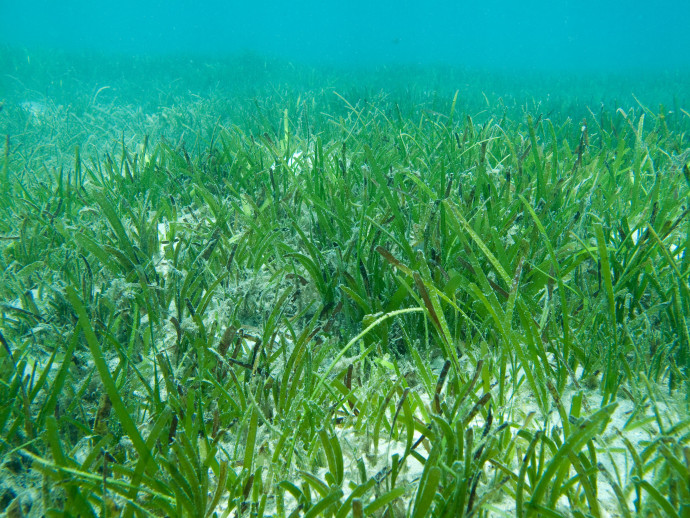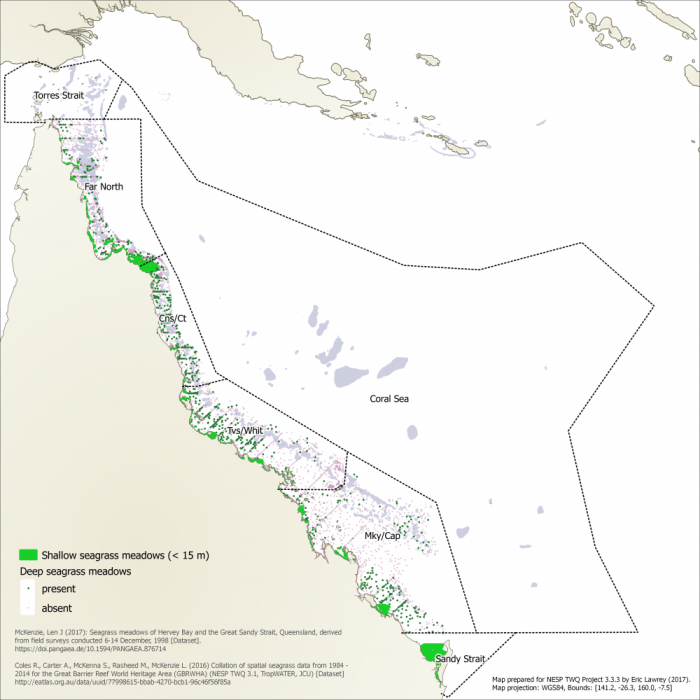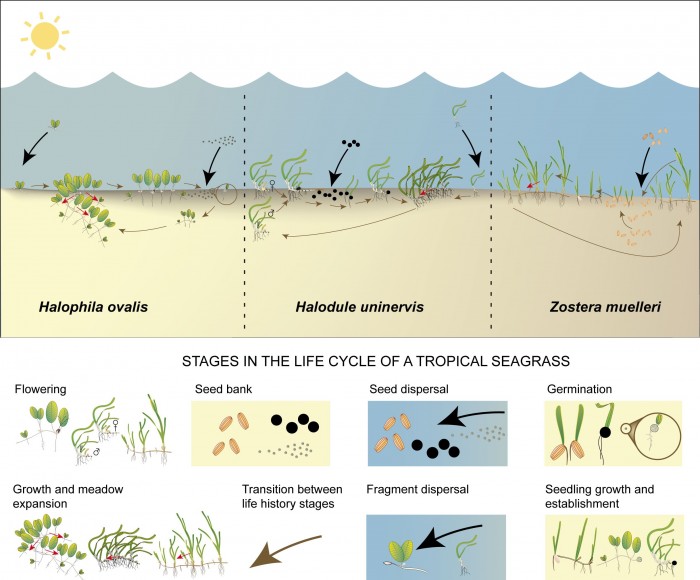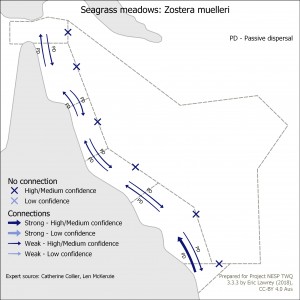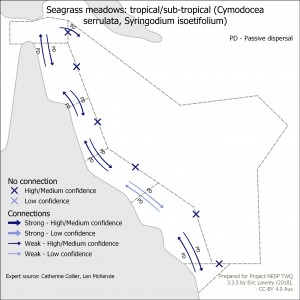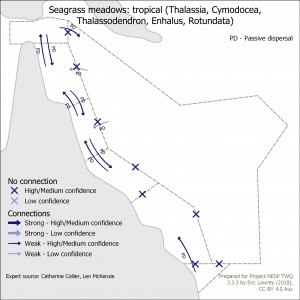Seagrass connectivity
What is seagrass and why it is important?
Seagrasses are marine plants found in estuaries, reefs and deep water environments throughout the northeast Australian seascape (Figure 2). They form meadows that provide nutrient-rich habitat for many animals, for example, sea cucumbers, fish, urchins, marine turtles, dugongs, sharks and rays all use seagrass meadows at some time during their life cycle. Seagrass meadows provide important ecosystem services, such as food and shelter, nutrient cycling, nursery habitat and carbon sinks (Coles et al. 2015, Nordlund et al. 2016). The highest diversity of seagrass worldwide is in tropical waters, with an estimated 15 species of seagrasses in the northeast Australian seascape (Waycott et al. 2004).
Key concepts that relate to connectivity
Most seagrasses use water movements for pollen and seed dispersal and some species employ animal assisted seed dispersal to reproduce (Tol et al. 2017) (Figure 3). Both forms of dispersal can transport seeds long distances and support seagrass recruitment to locations many kilometres from their source (Grech et al. 2016, 2018). This long-distance dispersal also enhances the clonal diversity of meadows and therefore their resilience. This is the primary type of connectivity of seagrass meadows in the northeast Australian seascape (see Figures 4a-d). Seagrass meadows are an important coastal habitat that is threatened by human and natural disturbances, including urban and agricultural runoff, boat damage, fishing, cyclones and storms, and dredging (Waycott et al. 2009, Grech at al. 2018, McKenzie et al. 2017), and they at risk of thermal stress due to the changing climate (Collier et al. In press). Importantly, information on connectivity can provide insight into how activities in one area can impact seagrass in other areas by affecting seed stocks and distant recruitment. Any loss of seagrass habitat will have consequences for the animals that depend on it for food, shelter and breeding, such as dugongs and marine turtles.
References
AIMS ProjectNET: https://www.aims.gov.au/docs/projectnet/seagrasses.html
Coles, R.G., Rasheed, M.A., McKenzie, L., Grech, A., York, P.H., Sheaves, M., McKenna, S., Bryant, C. (2015) The Great Barrier Reef World heritage Area seagrasses: managing this iconic Australian Ecosystem resource for the future. Estuarine, Coastal and Shelf Science, 153:A1-A12.
Collier, C., Waycott, M. (2009) Drivers of change to seagrass distributions and communities on the Great Barrier Reef: Literature review and gaps analysis. Reef and Rainforest Research Centre Limited, Cairns.
Collier, C.J., Langlois, L., Ow, Y.X., Johansson, C., Giammusso, M., Adams, M.A., O'Brien, K., Uthicke, S. (In press) Losing a winner: thermal stress and local pressures outweigh the positive effects of ocean acidification for tropical seagrasses.
Grech, A., Wolter, J., Coles, R., McKenzie, L., Rasheed, M., Thomas, C., Waycott, M., Hanert, E., Schoeman, D. (2016) Spatial patterns of seagrass dispersal and settlement. Diversity and Distributions, 22:1150-1162.
Grech, A., Hanert, E., McKenzie, L., Rasheed, M., Thomas, C., Tol, S., Wang, M., Waycott, M., Wolter, J., Coles, R. (2018) Predicting the cumulative effect of multiple disturbances on seagrass connectivity. Global Change Biology.
McKenzie, L., Collier, C.J., Langlois, L., Yoshida, R.L., Smith, N., Waycott, M. (2017) Marine Monitoring Program: Inshore seagrass annual report for seagrass monitoring 2015-16. Great Barrier Reef Marine Park Authority, Townsville.
Nordlund, M., Koch, L.E.W., Barbier, E.B., Creed, J.C. (2016) Seagrass Ecosystem Services and Their Variability across Genera and Geographical Regions. PLoS ONE, 11:e0163091.
SeagrassWatch: https://www.seagrasswatch.org/
Tol, S.J., Jarvis, J.C., York, P.H., Grech, A., Congdon, B.C., Coles, R.G. (2017) Long distance biotic dispersal of tropical seagrass seeds by marine mega-herbivores. Scientific Reports, 7:4458.
Waycott, M., McMahon, K., Mellors, J., Calladine, A., Kleine, D. (2004) A guide to tropical seagrasses of the Indo-West Pacific. James Cook University, Townsville, 72pp.
Waycott, M., C. M. Duarte, T. J. B. Carruthers, R. J. Orth, W. C. Dennison, S. Olyarnik, A. Calladine, J. W. Fourqurean, K. L. Heck, A. R. Hughes, G. A. Kendrick, W. J. Kenworthy, F. T. Short, and S. L. Williams. (2009) Accelerating loss of seagrasses across the globe threatens coastal ecosystems. Proceedings of the National Academy of Sciences 106:12377-12381.




